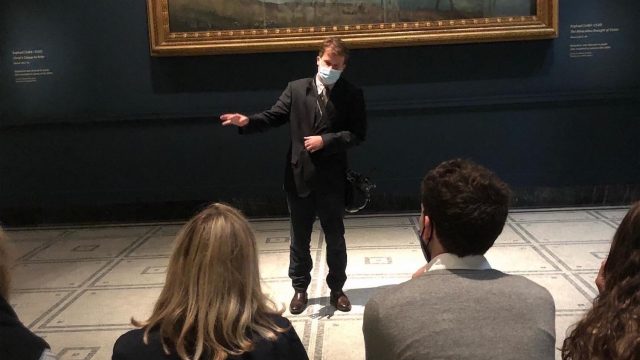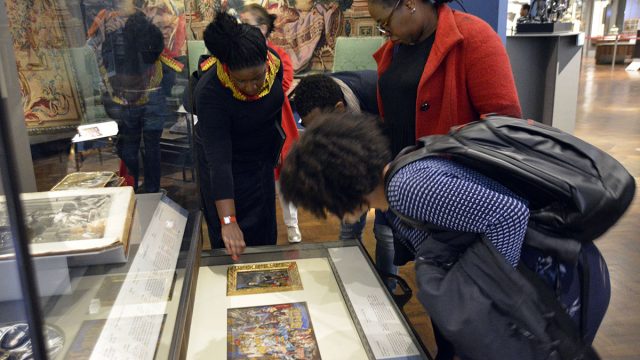For sheer drama and eccentric plot, there is little to beat ‘The Martyrdom of St Ursula and the 11,000 Virgins,’ a Northern Renaissance painting which shows poor Ursula and her companions being slaughtered by a band of Huns. The picture can be found in room 50b, within the Medieval and Renaissance galleries.
According to legend, Ursula was a beautiful and pious daughter, of a Christian King, either from Britain or Brittany, depending on which version of the tale you pick. She was promised to a pagan Prince in exchange for his agreement to convert to Christianity, and allowing her to make a pilgrimage to Rome, accompanied by 11,000 virgins, before they are to be wedded. They sailed up the (river) Rhine to Cologne and then travelled overland to Rome. On their return, they had the misfortune to bump into the Huns who were besieging Cologne. Ursula and her companions were martyred after she refused to marry the leader of the Huns.
The picture below dates from around 1492, and was one of a series of nineteen paintings about Ursula’s life, commissioned by a church in Cologne from an artist known as the Master of the St Ursula Legend.

The scene in the V&A picture is based upon a 12th century version of the legend, which arose after building workers came across numerous graves and human remains, outside the city walls of Cologne. It was probably an old Roman burial site, but the idea soon spread that these were the remains of Ursula and her companions.
The picture gives a major role to Etherius, Ursula’s fiancé, who is shown dying in her arms. On the left, the Pope or rather ex-Pope, Cyriacus, who met a sticky end, since the legend was that he had been so smitten by Ursula and the virgins when they visited him in Rome, he handed in his resignation and followed them to Cologne.
The leader of the Huns stands next to Ursula, presumably about to make his offer of marriage before the final massacre. There is some fine gory detail, such as severed heads, as well as streams of blood. Above, the angels take the martyrs’ souls up to heaven. The virgins have rather round, venerated faces, while the Huns have more individualised and realistic faces and wear ornate garb.
The fable attracted artists from Germany, Italy and Spain, between the 12th and 15th century. The Legend of St Ursula is a contentious one, but nonetheless, a tragic one, which has inspired painters over the ages, notably, and most famously Italian artist Caravaggio (1571-1610), of whom it is thought to be the last picture he painted before his death, entitled ‘The Martyrdom of Saint Ursula’ in (1610) which resides in Naples.
If Northern Renaissance painting is something you appreciate, then I urge you to come and view ‘The Martyrdom of St Ursula and the 11,000 Virgins,’ at the V&A, as it will not disappoint.



I woke up remembering in my dream the word Ursula. I knew nothing of this legend until I read this. Very Strange indeed.